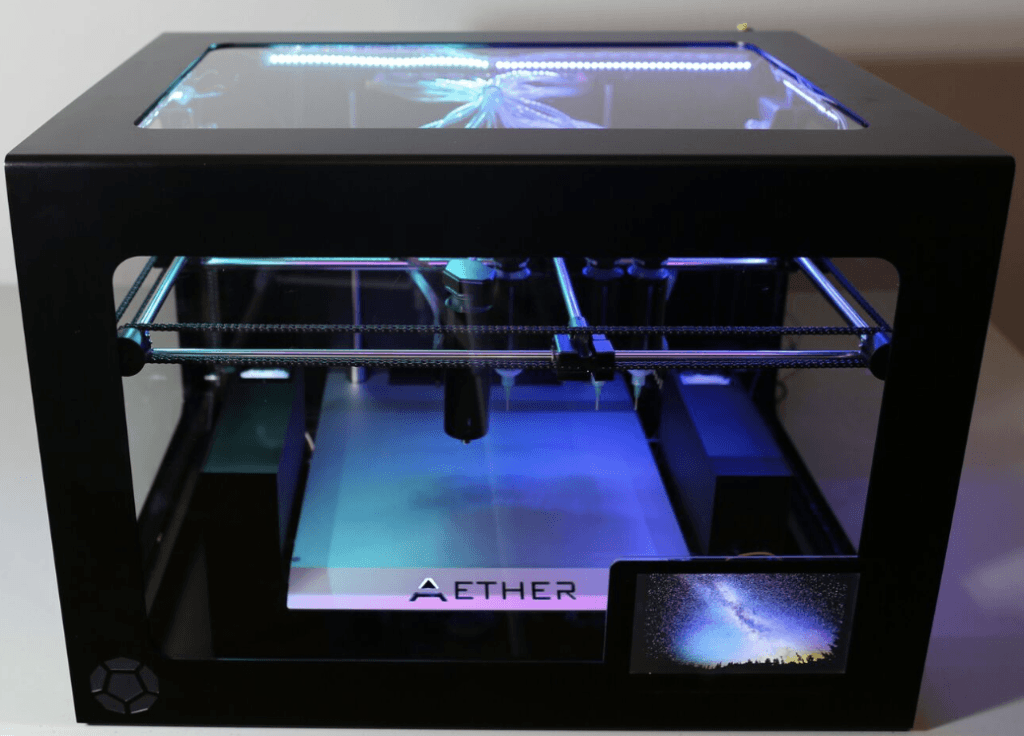First Beta Unit of the Aether 1 Bioprinter Ships to the University of Cambridge, Ready to “Absolutely Transform the Entire Bioprinting Market”
 About a year ago, a startup called Aether seemed to come right out of the ether, promising a bold new 3D bioprinter with more than 20 swappable extruders. The multipurpose Aether 1 sounded too good to be true, especially coming from a new, unknown company, but it’s already gotten serious interest from a number of universities and research institutions, several of which have signed on to participate in a large-scale research project using Aether 1 beta units.
About a year ago, a startup called Aether seemed to come right out of the ether, promising a bold new 3D bioprinter with more than 20 swappable extruders. The multipurpose Aether 1 sounded too good to be true, especially coming from a new, unknown company, but it’s already gotten serious interest from a number of universities and research institutions, several of which have signed on to participate in a large-scale research project using Aether 1 beta units.
A few days ago, that project officially began as Aether shipped their first beta unit to the University of Cambridge. Bioengineering professor Dr. Yan Yan Shery Huang, along with her student Elisabeth Gill, will be the first to try out the Aether 1. Dr. Huang specializes in bioengineering, with a particular focus on bioprinting and other novel fabrication techniques – and the Aether 1 certainly meets the criteria for novel fabrication. Aether hopes that the machine will make a valuable contribution to Dr. Huang and Gill’s research, but the pair will also assist in the printer’s further development by testing it and offering feedback.
“Since this is the very first beta unit, it’s a bit ‘raw’ and there are many improvements that need to be made, and problems that remain to be solved,” Aether states. “As our first beta users, they will likely discover new issues, both large and small, that we aren’t aware of yet.”
The Aether 1, in addition to its bioprinting capabilities, offers multiple other fabrication options from food printing to electronics printing to laser engraving. According to Aether, the printer’s major core functions, including options for FDM/FFF 3D printing, syringe extrusion, droplet jetting, and laser engraving, are in place and have been performing well in tests, as are the machine’s four primary automation features: machine vision-based fully automatic air pressure calibration; automatic true mechanical stage leveling; dual automatic multi-function cleaning stations; and automatic offset calibration.

The Aether 1, shown with seven standard syringe extruders, one heated glass syringe extruder, and five solenoid microvalve droplet jets.
The Aether 1’s automated features are one of its key selling points, in addition to its multitudinous fabrication capabilities. Bioprinting is no simple task, but according to Aether, they’ve made it a lot easier by automating the most complicated and time-consuming parts of the process, ensuring accuracy by replacing “eyeball approximations” with precise sensors and algorithms.
The printer is also remarkably inexpensive at $9,000. Other high-end bioprinters can run as expensive as $250,000 or more, while offering fewer extruders and fabrication methods, and “maybe 1 automation method,” as the company’s CEO tells us. He continues, noting that more comparably priced ($10K-$20K) bioprinters offer even fewer extruders and fabrication methods, with zero automation.
“Aether 1 has up to 24 extruders, 8 fabrication methods, and 4 never-before-seen, totally revolutionary automation features. It crushes the high-end, but it’s priced on the low-end,” Aether CEO Ryan Franks tells 3DPrint.com. “Aether’s shipment to Cambridge marks the beginning of a radical paradigm shift for what researchers can do with a bioprinter, which will soon absolutely transform the entire bioprinting market.”
 As the Aether 1 shipped out to Cambridge, the company was in transit as well, moving from their cramped 250-square-foot office to a 2,600-square-foot office in San Francisco’s South of Market (SoMa) district. A larger space has become increasingly necessary as Aether adds to their team; recently they expanded their engineering team and are looking to further increase its size.
As the Aether 1 shipped out to Cambridge, the company was in transit as well, moving from their cramped 250-square-foot office to a 2,600-square-foot office in San Francisco’s South of Market (SoMa) district. A larger space has become increasingly necessary as Aether adds to their team; recently they expanded their engineering team and are looking to further increase its size.
Production will be scaling up as well; Aether hopes to ship additional beta units out towards the end of the month, with the goal of sending them to all of the institutions that have signed on for research collaborations as soon as possible. Discuss in the Aether forum at 3DPB.com.
Subscribe to Our Email Newsletter
Stay up-to-date on all the latest news from the 3D printing industry and receive information and offers from third party vendors.
You May Also Like
3D Printing Unpeeled: New Arkema Material for HP, Saddle and Macro MEMS
A new Arkema material for MJF is said to reduce costs per part by up to 25% and have an 85% reusability ratio. HP 3D HR PA 12 S has been...
3D Printing News Briefs, January 20, 2024: FDM, LPBF, Underwater 3D Printer, Racing, & More
We’re starting off with a process certification in today’s 3D Printing News Briefs, and then moving on to research about solute trapping, laser powder bed fusion, and then moving on...
3D Printing Webinar and Event Roundup: December 3, 2023
We’ve got plenty of events and webinars coming up for you this week! Quickparts is having a Manufacturing Roadshow, America Makes is holding a Member Town Hall, Stratafest makes two...
Formnext 2023 Day Three: Slam Dunk
I’m high—high on trade show. I’ve met numerous new faces and reconnected with old friends, creating an absolutely wonderful atmosphere. The excitement is palpable over several emerging developments. The high...
































